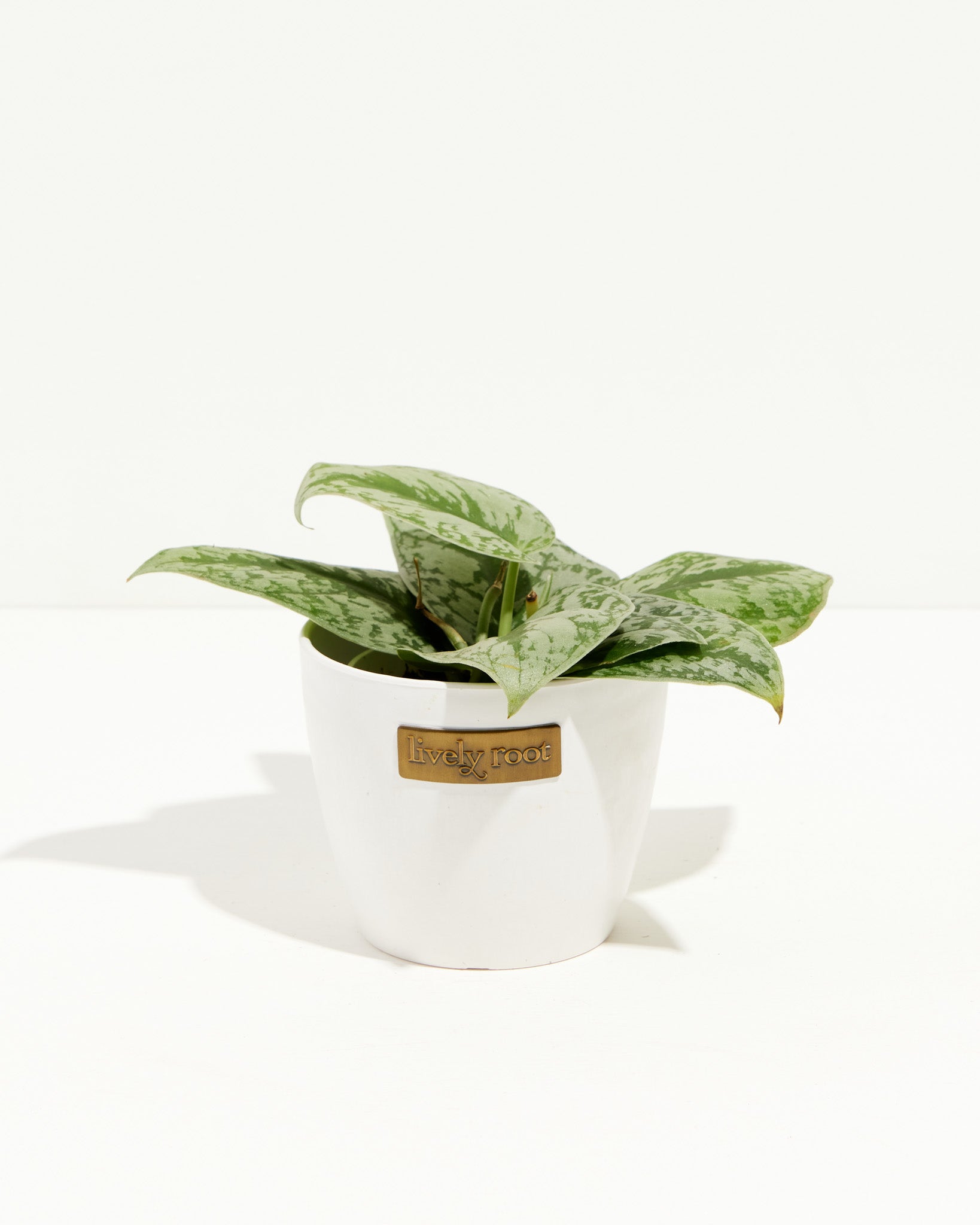

Our Silver Satin Pothos (Scindapsus pictus 'Exotica') is really not a pothos, but its common name picks up the many similarities in nature and looks. It grows to be 3 feet indoors and carries with it a unique appeal of shimmer and glisten on the silver splashes that appear to drip from its heart-shaped leaves that are curvaceous to one side. Admire her best hanging or trained up a trellis or moss pole to fully gaze on her leaves of silver. She's definitely a wall candy treat!
Silver Satin Pothos Care Guide & Presentation

This plant prefers bright, indirect light to promote leaf growth!
Keep the soil slightly moist and water when the soil reaches #5 on the moisture meter. Use filtered, bottled, or tap water sitting 24 hours to release the chemicals and water enough to discharge out of the drainage holes. Once the water is fully drained, place her into the cache or decorative pot. Don't let her roots sit in standing water or in the saucer. Water less frequently during the winter months but keep it humid around the plant.
Average humidity levels at least 40-50%% is adequate for this plant's needs.
Ideally, the Pothos 'Silver Satin' likes it on average of 65-70° at night and upwards of 86°F during daylight hours. If temperatures dip below 60°F, it will protest.
If grown outside on a porch, keep it's leaves in shade or the sun can scorch it's leaves. Low light conditions however, can cause the leaves to lose their coloring.
Fertilize every month during its growing period in the spring and summer with an organic fertilizer. Let the plant rest in the fall and winter.
When receiving the plant, do not repot immediately but wait at least 6-12 months or if the roots are beginning to get crowded and growing through the drainage holes. Repot in the spring, using a 2" bigger pot to keep the roots drier. (Too big of a pot could cause the soil to dry slower, which is not helpful.) Use a well-draining indoor potting mix with coir and perlite to help with drainage. Water your plant in the old pot before transferring over and let it sit an hour. Place a piece of screening at the bottom of the container over the drainage hole to secure the soil and allow it to drain. Add soil to the bottom to elevate the root ball. Lift the plant and release the roots against the existing planter. Use a clean knife or garden trowel to wedge between the pot and the soil to loosen. Inspect the root ball. Notice if there are any dead or rotting roots and trim off with sterile pruners. If the plant is rootbound, cut through the roots to alleviate continued encircling. Ensure the plant is sitting about 1" below the edge of the pot to avoid water spillage. Add more soil and backfill around the sides by tamping down. Fill up to the soil line but not over. Water thoroughly, leaving the soil damp but not soggy. If settling occurs, add more soil.
Prune the long vines of your Scindapsus to control her from looky twiggy. Also, you'll encourage new growth. Prune during the spring and summer months and only remove 25% of the branches or as needed to keep it full and shapely.
Stem Cutting: In early spring, take a pothos cutting, use sharp pruners to remove a cutting from a tip off the vine. Cut at least 5-6 inches of stem to propagate. Place in a vase with water to root. Change the water each week with filtered, bottled, or tap water sitting at least 24 hours. After 3-4 weeks, check to make sure the stem has 1-2 inch, well-formed roots. If so, it's time to plant. *Fill a small container with drainage holes (too large of a container for the cutting will make it challenging to regulate watering needs) using an indoor well-draining potting mix. Mix a little rooting hormone into the soil. Poke a hole in the soil with a pencil. Then, place the cutting in the hole and tamp the soil down around it. Water the plant and keep it in medium to bright indirect sunlight. After 4-6 weeks, the roots should establish. Division: Divide the Pothos Silver Satin in the early spring when emerging from dormancy. Pull from the container and cut through the roots with a sharp knife or pruners. Repot in a rich, indoor potting soil mix. Use a container 2 inches bigger than the root ball with drainage and is deep enough for the roots to grow. Place the roots at the same level as the previous pot adding soil at the bottom if necessary. Set it in bright, indirect sunlight and water. Check the moisture and humidity each day and add misting to keep the soil moist while the roots establish. After 6-8 weeks, roots will begin to form. You can tug onto the stem to ensure the roots are establishing.
Silver Satin Pothos: Overview
The Silver Satin Pothos (Scindapsus pictus 'Exotica') is a vining plant with beautiful, green, heart-shaped leaves splashed with silver-white. The plant is known as Satin Pothos, due to the shimmering effect of its silky-textured leaves. You can train this amazing indoor plant to climb, provided with the right support, or grow it as a spectacular hanging plant, trailing its lovely, long vines from a hanging basket.
This pretty, silvery tropical vine is native to Southeast Asia and can grow outdoors in warm climates (hardiness zones 11-12). The Silver Scindapsus belongs to the Araceae family, and despite its common name, it’s not a true Pothos (Epipremnum aureum). This low-maintenance plant prefers bright sunshine but adapts to various growing conditions. Pothos Silver Satin is toxic to pets because it contains calcium oxalate crystals.
Satin Pothos symbolizes enduring growth and resilience, and its symbolic meaning and delicate beauty make it a charming and encouraging gift.
Satin Pothos: Benefits
- One of the top NASA-researched air-purifying plants
- Perfect decorative vine for homes and offices
- Fast-growing, easy-care, and undemanding plant
- Adaptable to various growing conditions
Scindapsus vs Pothos
Silver Satin Pothos (Scindapsus pictus) isn’t the same plant as real Pothos (Epipremnum aureum), like variegated Pothos Pearl Jade or Golden Pothos. The two plants are similar in being easy to care for and having similar growing requirements. They thrive in bright but indirect sun and need medium watering.
Also, both plants have heart-shaped leaves and a vine-like growing habit, using aerial roots for climbing. However, Satin Pothos' aerial roots are more delicate than the Pothos plant’s robust roots. Real Pothos’ leaves are glossy, whereas the Silver Pothos has a velvety leaf texture. The leaves of the Scindapsus pictus plant tend to have silvery tones, whereas Pothos varieties often display golden, yellow, or creamy-colored variegations.
Satin Pothos: Care Guide
Caring for Satin Pothos is easy; it’s an adaptable plant that thrives with little attention. Here are the most important Satin Pothos care tips to keep your vine lush and beautiful:
Watering and Humidity
The Scindapsus Silver Satin plant needs regular watering. Let the water drain completely before replacing the plant in its decorative pot; it doesn’t like standing in water. Keep the humidity high around the plant.
Light and Temperature
Bright, indirect light is the best light condition for your Satin Pothos. As a tropical plant, the Exotica Pothos needs warm temperatures, ranging from 65°F to 85°F, to thrive.
Soil, Feeding, and Repotting
Always use well-draining soil for your Satin Pothos plant. Mix in some perlite to enhance drainage. Fertilize monthly with an organic fertilizer during the growing season. Repot your plant into a 2-inch larger pot when you notice roots growing from the old pot’s drainage holes. Water the plant well in advance before repotting. Remember to wear garden gloves to protect your hands from the plant’s sap, which can cause skin irritation.
Propagation
Another benefit of this lovely plant is that Satin Pothos propagation isn’t tricky. Take several stem cuttings from your plant in early spring and put them in a transparent vase with water. Regularly change the water until you see the cuttings developing roots. When the roots are 1-2 inches long, you can plant the cuttings in soil.
Pruning, Cleaning, and Common Issues
Prune your Silver Satin vine when necessary to keep it looking bushy. You can also clean its leaves occasionally with a shower to remove dust.
Silver Satin Pothos care includes checking the leaves regularly for pests or other issues. Yellowing leaves are often a sign of overwatering; water only when the top inches of the soil get dry to avoid this issue. Low light can cause the leaves to lose their beautiful silvery variegation and look faded. Make sure your plant receives enough light to keep its colors bright.
Silver Satin Pothos: Placement, Companion & Alternative Plants
Silver Pothos is an attractive, easy-care vine that will charm your living space, whether you grow it in a hanging basket or let it climb up a moss pole.
Best Locations & Uses
- Perfect for bedrooms because of its air-purifying qualities
- Ideal for plant lovers with no pets
- Can thrive as a porch plant in warmer climates, placed in indirect sunlight
- Easy to care for and suitable for beginner gardeners
- Great vine for interior decoration that looks amazing in hanging baskets or draped around doorways and mirrors
Companion Plants
Combine your Silver Satin plant with other tropical houseplants to enhance your home and increase the humidity in your living space:
- Syngonium Holly Bianco (Syngonium podophyllum): The Syngonium Holly Bianco has large, arrow-shaped, silvery leaves, one of the more compact, non-vining Syngonium varieties.
- Black Raven ZZ Plant (Zamioculcas zamiifolia 'Black Raven'): A striking conversation starter, the Black Raven ZZ Plant has exotic-looking, dark leaves and is also known as an excellent air purifier.
- Chinese Money Tree Plant (Pilea peperomioides): The unusual coin-like leaves of the Chinese Money Tree Plant make an eye-catching contrast when combined with other plants.
Alternative Plants
As Pothos Exotica is toxic to pets if ingested, pet owners may want to consider some of our pet-friendly plants:
- Peacock Plant (Calathea roseopicta): The Peacock Plant is a popular prayer plant with fascinating variegated leaves in green and yellow, and dark-red undersides. .
- Spider Plant (Chlorophytum comosum): A perfect choice for hanging baskets, the Spider Plant is easy to take care of and an amazing indoor air purifier.
- Silver Queen Air Plant (Tillandsia): Growing by attaching itself to natural trees, the Silver Queen Air Plant is an epiphyte that doesn’t need any soil, making it an excellent choice for mess-free indoor gardens.
Order Your Satin Pothos From LivelyRoot Today!
Enhance your home’s aesthetics with the gorgeous Pothos Silver Satin, available for sale and delivered to your doorstep by Lively Root!
























